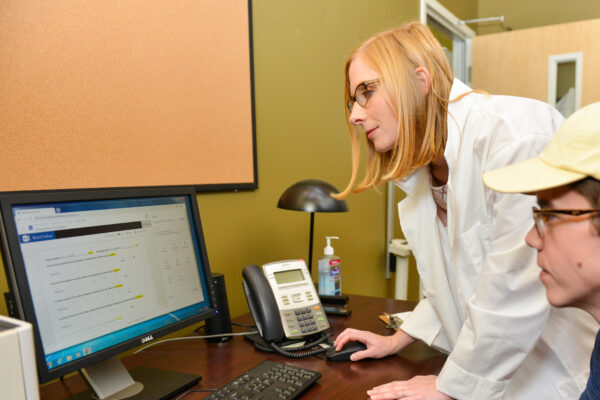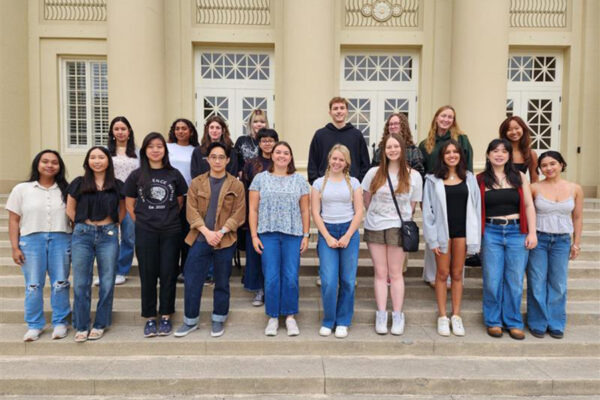A year after Chapman University’s School of Pharmacy admitted its first class in 2015, Rennolds Ostrom joined the faculty.
“I was excited about what was being built here from scratch and Chapman also aligns with my love of teaching,” he says.
Two years after being named interim dean, Ostrom became the second dean in the school’s history in March. In a decade, the School of Pharmacy has built its research capabilities from scratch, risen in the rankings and turned out graduates who pass the national licensing exam and match to residencies at rates above the national average.
“Coming up on 10 years, I think we’re really seeing tremendous progress in what we’re able to accomplish and the metrics in terms of student success,” he says.
The School of Pharmacy was established in 2013 at Chapman’s Rinker Health Science campus under founding dean Ron Jordan, and admitted its first class in fall 2015. It was the first pharmacy school in Orange County.
“There are no pharmacy schools that have opened in the last 30 years that have built research from scratch the way we did here,” Ostrom says.
The school has been a confluence of strong research and student-focused teaching. Faculty regularly earn grants from agencies like the National Institutes of Health while retaining a robust teaching load, underscoring the school’s commitment to the teacher/scholar model for faculty.
“We have incredible faculty,” Ostrom says. “Not all researchers are passionate about teaching, but many of us are. Those who are passionate are a good fit for a school like ours. They align with the teaching-first DNA of Chapman.
“As we produce students who have role models like our faculty, they’re going out and spreading that further.”
In the future, Ostrom wants the school to reach the top 50 overall and the top 25 for research nationwide. Whatever innovating the school does will serve students’ success and support high-level research.
“If we can continue to invest in and further those two areas, the ranking will follow,” Ostrom says.
Ostrom is also cultivating relationships with other health care entities like City of Hope and Providence. Chapman partners with other care providers and research centers to give students further hands-on experience.
Ostrom knows that the pharmacy profession is changing rapidly. Pharmacists don’t just dispense medication, they are part of the health care ecosystem, caring for and counseling patients.
“Our students and faculty are at the forefront of that evolution,” he says.
Pharmacists are in every community and are one of the few health professionals with a doctoral education that a person regularly interacts with. This is compounded by a persistent shortage of health care workers and “medical deserts”, where residents’ health needs often go unmet.
“We need to produce top-quality health care professionals who can fill these roles and because there’s a pharmacy accessible to everybody, you’re able to help those in communities that don’t have good health care access,” Ostrom says.
The School of Pharmacy already has “excellent students who prepare well” and faculty who know how to train them, he says.
“We’ll keep finding the resources to allow us to continue to push the envelope and stay focused on student success,” he says.
10 Years, 10 Facts
- Kassidy Vo, 19, was the youngest pharmacist in the state when she graduated from CUSP in 2019.
- CUSP jumped almost 20 spots in the U.S. News & World Report rankings in 2024.
- CUSP is the No. 1 pharmacy school among R2 institutions in California for National Institutes of Health funding.
- CUSP is No. 3 nationwide for both NIH and total funding among R2 institutions (total funding in 2022/2023 was $4.1 million).
- CUSP students spend over a third of their time in experiential education, starting their first year.
- CUSP has more than 300 preceptors in California, giving students a variety of learning opportunities.
- CUSP has had 588 total graduates since its inception.
- Five CUSP faculty members were recognized as the world’s top 2% most cited scientists in 2022 by Stanford University.
- Participants in CUSP’s Pharmacy Summer Research Program for high school students have doubled each year since the program started in 2022.
- CUSP graduates in 2024 had an 87.9% North American Pharmacist Licensure Examination (NAPLEX) pass rate, almost 10 points above the national average.
Sources: American Association of Colleges of Pharmacy and Chapman University School of Pharmacy




